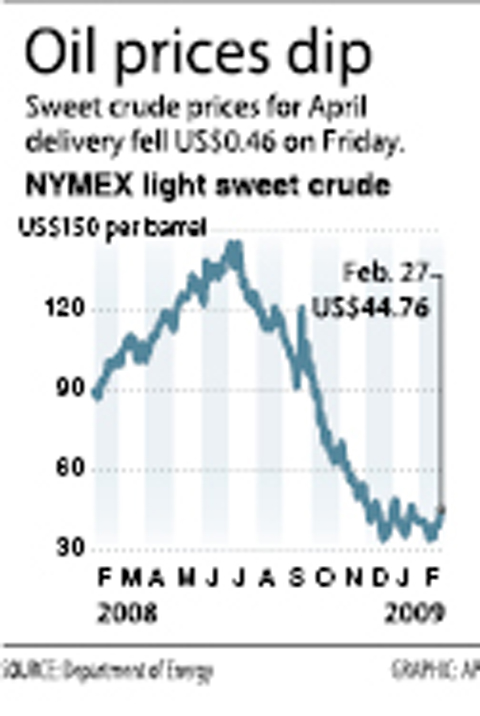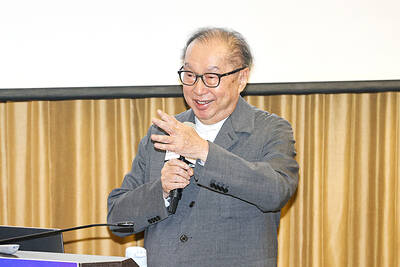World oil prices fell on Friday after three straight days of gains as government data showed the US economy shrank more sharply than expected in the fourth quarter of last year.
New York’s main contract, light sweet crude for April delivery, fell US$0.46 lower from Thursday’s close to end at US$44.76 a barrel.
In London, Brent North Sea crude for April shed US$0.16 to US$46.35 per barrel.

“The market reacted negatively to the GDP figure that came out this morning,” Andy Lipow at Lipow Oil Associates said.
The US economy contracted a stronger-than-expected 6.2 percent in the fourth quarter, the US Commerce Department said just before markets opened Friday, highlighting the meltdown in activity late last year in the world’s biggest oil consuming nation.
The figure was far worse than the negative 5.4 percent annual rate expected by most analysts and the sharpest contraction since the first quarter of 1982.
Oil prices recovered slightly from their lows in line with stocks in late trading, traders said.
“The crude market is wrestling with the fact they’re not sure whether OPEC cut enough production given the decline of demand that we’ve seen,” Lipow said.
Oil prices had surged in recent days in reaction to rising US gasoline stocks and clear indications of output cuts by OPEC.
OPEC announced late last year output cuts of 4.2 million barrels per day in a bid to reverse tumbling prices, and members looked to be sticking to the planned reductions.
“If current price levels do prove to be the base from which oil prices rise, it is going to be a long hard climb, at best,” John Kilduff of MF Global said. “Summer driving season may turn out to be a bust, if consumers choose to stay cautious this year.”
Crude oil prices covered a range between US$37.65 and Thursday’s high of US$45.30 this week, he said.
“The week’s high represented over a 9 percent improvement from last Friday’s settlement, against a very grim macroeconomic backdrop,” he said.

BYPASSING CHINA TARIFFS: In the first five months of this year, Foxconn sent US$4.4bn of iPhones to the US from India, compared with US$3.7bn in the whole of last year Nearly all the iPhones exported by Foxconn Technology Group (富士康科技集團) from India went to the US between March and last month, customs data showed, far above last year’s average of 50 percent and a clear sign of Apple Inc’s efforts to bypass high US tariffs imposed on China. The numbers, being reported by Reuters for the first time, show that Apple has realigned its India exports to almost exclusively serve the US market, when previously the devices were more widely distributed to nations including the Netherlands and the Czech Republic. During March to last month, Foxconn, known as Hon Hai Precision Industry

Taiwan Semiconductor Manufacturing Co (TSMC, 台積電) and the University of Tokyo (UTokyo) yesterday announced the launch of the TSMC-UTokyo Lab to promote advanced semiconductor research, education and talent development. The lab is TSMC’s first laboratory collaboration with a university outside Taiwan, the company said in a statement. The lab would leverage “the extensive knowledge, experience, and creativity” of both institutions, the company said. It is located in the Asano Section of UTokyo’s Hongo, Tokyo, campus and would be managed by UTokyo faculty, guided by directors from UTokyo and TSMC, the company said. TSMC began working with UTokyo in 2019, resulting in 21 research projects,

Ashton Hall’s morning routine involves dunking his head in iced Saratoga Spring Water. For the company that sells the bottled water — Hall’s brand of choice for drinking, brushing his teeth and submerging himself — that is fantastic news. “We’re so thankful to this incredible fitness influencer called Ashton Hall,” Saratoga owner Primo Brands Corp’s CEO Robbert Rietbroek said on an earnings call after Hall’s morning routine video went viral. “He really helped put our brand on the map.” Primo Brands, which was not affiliated with Hall when he made his video, is among the increasing number of companies benefiting from influencer

Quanta Computer Inc (廣達) chairman Barry Lam (林百里) yesterday expressed a downbeat view about the prospects of humanoid robots, given high manufacturing costs and a lack of target customers. Despite rising demand and high expectations for humanoid robots, high research-and-development costs and uncertain profitability remain major concerns, Lam told reporters following the company’s annual shareholders’ meeting in Taoyuan. “Since it seems a bit unworthy to use such high-cost robots to do household chores, I believe robots designed for specific purposes would be more valuable and present a better business opportunity,” Lam said Instead of investing in humanoid robots, Quanta has opted to invest